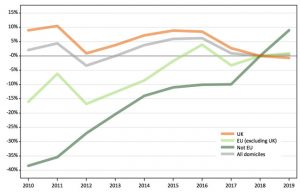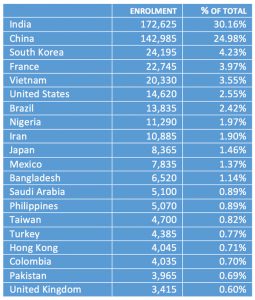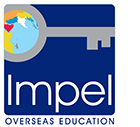What does an Overseas Education Consultant do?
In the era where the entire world is just a click away, sometimes things do get tough when you are planning your education and career out of India. It is then that overseas education consultants come to the rescue.
Overseas Education Consultants are the professionals who have expert knowledge about the courses offered by different countries and universities as well as their admission process, visa application procedures, and other formalities. Some of the best consultants in India are IDP, Global Education, and Impel Overseas Consultants.
A good overseas consultant is aware of both the immigration as well as education market. For the purpose of education, a good consultant should be able to advise you on student education loans, scholarship schemes across different countries and colleges.
How to choose?
To choose the best overseas education consultant near you, you should keep in mind the following pointers:
- Selection – If your educational consultant is helping you majorly with the shortlisting, selection and pursuance of the best University you may land at, and give you help from collaborations, you are at the right place. Seek out all the options offered to you and weigh them according to your needs as well as aspirations.
- Preparation – Once you are done with your shortlisting, your overseas education consultant must be able to help you prepare for entrance examinations, english tests and other foreign language tests for eligibility. They will provide you with the material and one-to-one support.
- Immigration – For all visa requirements including visa processing, verification and visa interview, your consultant must take you through the process smoothly to ensure there are no last-minute hassles and glitches.
- Financing – An educational consultant must guide you through the financing of your course and suggest to you the best methods to procure scholarships, exemptions and loans that are needed. It should also give you a comparative list of pros and cons, and the perks available under the tuition fee of all prospective educational institutions.

Image Source: LeverageEdu
Takeaway
If your study abroad consultant hunt is still on, you can visit the websites of or contact for further information, at your convenience. For your help, you can check out the following:
- Impel Overseas Education Consultants
- Global India
- IDP Education Consultancy
- Edwise International
- iSchoolConnect
- Manya – The Princeton Review
- Eduworld
US confirms increase in student visa fees
The US Department of Homeland Security (DHS) confirmed this month that it is moving forward with significant increases in student visa fees.
All study visa applicants to the US are obliged to pay a fee that is levied by DHS’s Student and Exchange Visitor Program (SEVP) in order to cover the costs of administering the Student and Exchange Visitor Information System (SEVIS). As DHS explains, SEVIS is used by the government to maintain information on Student and Exchange Visitor Program (SEVP)-certified schools, F-1 and M-1 students who come to the United States to attend those schools, US Department of State-designated Exchange Visitor Program sponsors and J-1 visa Exchange Visitor Program participants. It is a critical tool in our mission to protect national security while supporting the legal entry of more than one million F, M and J nonimmigrants to the United States for education and cultural exchange.
Effective 24 June 2019, DHS confirms that it will increase fees charged to students formally referred to he 1-901 SEVIS Fee as follows:
- The I-901 SEVIS Fee for F and M international students that is, for students engaged in academic studies will increase from $200 to $350. This represents a 75% increase.
- Those visiting the US on exchange programmes are in a different visa category, and apply for J-class visas. Those exchange visitors in the au pair, camp counselor, and summer work travel programme participant categories will continue to pay the current $35 I-901 SEVIS Fee. However, fees will use for all other J-class exchange visitors, from $180 to $220 (a 22% increase).
SEVP is funded entirely by fees, and does not receive any appropriated funding from Congress, said SEVP Program Director Rachel Canty, in explaining the increase. SEVP’s fees have not changed since 2008, although our costs have continued to grow due to inflation, expanded programme operations and enhancements to [SEVIS]. The new and increased fees will enable the programme to continue to provide oversight of international students and SEVP-certified schools.
Educator concerns
Peak international education bodies in the US were quick to respond when the fee increases were first proposed in fall 2018. In a letter to SEVP’s unit chief in September 2018, NAFSA’s Deputy Executive Director of Public Policy, Jill Welch, said that, These dramatic increases come at a particularly inopportune time, as higher education institutions face significant funding challenges, and international education programmes are experiencing declining new enrolments for the first time in more than a decade.
She added, We anticipate that vigorous competition for international students from other countries that are currently expanding their enrolments will continue to exacerbate the early declines programmes are currently experiencing. Burdening students and exchange visitors with drastically increased fees may further contribute to declining enrolment, particularly in short-term programmes, and increased fees and steep new recurring fees may place some programmes in financial jeopardy…US immigration policies should be carefully crafted to avoid fueling the perception that the United States no longer welcomes international students or other international visitors.
Another joint letter from the executive directors of EnglishUSA, TESOL International Association, and UCIEP (University and College Intensive English Programs) echoes the point: We believe that such a significant increase in fees will have a number of negative consequences. In addition to creating additional financial barriers that will serve as a disincentive for students to study in the US, the proposed significant fee increase sends a signal to international students that they are not welcome. This could further reduce the number of international students who enroll in higher education institutions and English language programmes and therefore contribute to the national and local economies.
Fees for schools on the rise too
In addition to the increased fees for visiting students, DHS has also announced that fees charged to US schools will also be going up this year.
An existing fee for a schools initial SEVP certification will increase from $1,700 to $3,000.
The department will introduce a number of new fees for schools as well:
- A $1,250 fee for SEVP-certified schools filing for recertification.
- A $675 fee when schools file the Form I-290B, Notice of Appeal or Motion.
- DHS will maintain a current $655 fee for an initial school site visit but will now also charge this fee when a SEVP-certified school changes its physical location or adds a new physical location or campus.
Source: http://monitor.icef.com/2019/05/us-confirms-increase-in-student-visa-fees/
Irish university graduates earn more from degrees than in UK
Graduates from Irish universities stand to earn a slightly higher wage premium compared with graduates from some of the UK’s most prestigious universities over the course of their lifetime, according to new research.
The average lifetime net premium for an undergraduate degree holder from an Irish university has been estimated at €106,000 by research firm Indecon.
By contrast, there is a UK premium of £88,000 (€103,000) for graduates from the prestigious Russell Group universities.
This 24-member group includes the University of Cambridge, Oxford and the London School of Economics.
The same research indicates that in Irish universities, master’s degree holders’ net premium rises to €146,000 and Ph.D. holders’ net premium rises to €222,000.
These figures are net of tax and factor in the costs incurred by students in obtaining their degrees and income forgone during their years at university.
Universities’ role
The details are contained in the first ever socio-economic impact research undertaken on the role universities play in the economy.
The report was commissioned by the Irish Universities Association (IUA), which has been highlighting what it says is the absence of a sustainable funding model for Irish universities.
While the State invests about €2 billion into the higher education system each year, the report estimates that the Irish economy benefits by almost €9 billion from Ireland’s seven universities.
This is generated from a combination of premium on graduate earnings, the impact of research and income from overseas students.
It confirms that university graduates generate an income premium significantly beyond those with no third-level education and have consistently lower unemployment rates, even during the recession years.
The report also examines the impact of higher earnings among the cohort of new entrants to Irish universities last year.
It estimates that an individual undergraduate degree holder will generate a net gain for the exchequer of €62,000 over their lifetime in today’s money when all costs to the exchequer are taken into account.
Similarly, it estimates that Irish universities make a total research impact of €1.5 billion to the economy.
Prof Brian MacCraith, chairman of the IUA, said the report provided a rigorous scientific analysis of the economic return university education generated in Ireland.
‘Intolerable strain’
However, he warned that a 50 percent increase in student enrolments since 2000 was a precursor to an even greater demographic bubble which would place an “intolerable strain on the already under-resourced university system”.
“Unless the Government and the broader political community are prepared to deliver a sustainable core funding solution, the opportunities afforded to today’s students may be curtailed for many current and future primary and secondary students. As a society, we cannot let this happen,” Prof MacCraith said.
Alan Gray, managing director of Indecon, said Ireland had a more highly educated population than the EU average, which is often cited as a key reason both multinational organizations and indigenous enterprises base operations here.
“Our analysis shows the positive impacts that universities have on research and innovation, on graduates’ earning power and on the positive returns to the exchequer for their investment,” he said.
Visa extension to boost numbers of Overseas students in UK after Brexit
New measures will allow international students to seek employment for up to a year
International students will be given visa extensions of up to a year to look for work in the UK as part of a package of government measures to boost numbers of overseas students after Brexit.
The move represents a break with current policy, where students are allowed to stay for just four months after graduation.
Announcing the strategy, the Department for Education (DfE) said: “There is no limit on the number of international students that can study in the UK, and to ensure the UK continues to attract and welcome them, the post-study leave period will be extended to six months for undergraduate and master’s students, and a year for doctoral students.”
The announcement said the government would also consider “how the visa process could be improved for applicants and supporting student employment”, hinting at another possible change in policy.
Alongside the extended visas, the DfE and the Department for International Trade are to unveil an international education strategy with a 30% increase in overseas students in UK higher education during the next decade.
This would raise the number of non-UK students at British universities from 460,000 – including nearly 140,000 from the EU – to 600,000 by 2030, an ambitious target is given that EU students will face higher tuition fees and lose access to student loans after Brexit.
“As we prepare to leave the EU it is more important than ever to reach out to our global partners and maximise the potential of our best assets. That includes our education offer and the international students this attracts,” Damian Hinds, the education secretary, said.
Janet Beer, vice-chancellor of Liverpool University and chair of UniversitiesUK, said her organisation had been in discussion with the government about the strategy for the past six months.
She said: “International students contribute a huge amount to the UK, not only economically but also by enriching the international education environment in our universities for all students. While their presence in the UK is worth an estimated £26bn in direct and knock-on effects, sustaining over 200,000 jobs in all parts of the UK, they bring much wider benefit to our academic and civic communities.
“We particularly welcome steps to improve the visa regime, including the extension of opportunities for our graduates to work in the UK once they graduate, to six months for undergraduates and master’s students, and a year for those who undertake PhDs.
“We would like the government to go further and extend this opportunity to at least two years and we will continue to urge them on this point.”
The visa extension follows a recommendation by the independent migration advisory committee last year, and the government’s own white paper on skills-based immigration published in December. Currently, all graduates can stay for up to four months after finishing their courses, although those with PhDs can apply for an additional year.
Source: https://www.theguardian.com/education/2019/mar/16/visa-extension-overseas-students-uk-brexit?CMP=Share_AndroidApp_Facebook
Non-EU applications to UK universities up this year
The UK application registry UCAS has released new data from its 15 January admissions deadline for the 2019/20 academic year, and so we now have an early view of what enrolment trends may look like for the coming year. “On time” applications received by January 15 are viewed as an important indicator of current demand for British higher education, though students continue to apply after the deadline as well.
Applications to British universities for 2019/20 are up overall, and this marks the first overall increase in three years. More than 561,400 applications were received by UCAS, nearly 2,500 more than at the same time last year.
While the overall growth for this year is marginal, it is being led by a 9% increase in applications from students from outside the European Union. This was driven in large part by a surge from China (+33% over 2018). Looking at the broader pool of applications, there was a 1% decrease in the number of applications from students in the UK, and applications from countries in the EU were up slightly by 1%.

Application volumes to UK universities by student domicile, 2010–2019. Source: UCAS
The healthy growth in non-EU applications and slight growth in EU applications was met with relief by university stakeholders in the UK. “In this time of uncertainty, it’s welcome news to see more EU and international students wanting to come and study in the UK,” said Claire Marchant, UCAS’s chief executive.
Still, the fact that Chinese applications account for so much of the increase is worrying to some who make the point that there needs to be more diversity within the international student population in the UK. Trend data illustrates the extent to which the population of Chinese in UK higher education has grown over the past decade. In 2010, there 4,450 Chinese applications registered, while for the 2019/20 year there were 15,880 plus another 5,100 from Hong Kong.
Looking at the new UCAS data, Nick Hillman, Director of the Higher Education Policy Institute, commented that,
“It is a shame that we are so dependent on one country for our international students … as I would like to see similar growth from other territories too. But I welcome the growth and I also think it will provide the UK with some real soft power benefits in the future, when these people graduate and go back to China with experience here on their CV.”
Needless to say, the same concern could be raised by many leading study destinations, including the US, Australia, and Canada. But in one interesting indication of the significance of China in British higher education enrolments, UCAS observes that there were more applications from China and Hong Kong this year (20,980 combined) than there were from Wales (18,850) or Northern Ireland (17,910).
Comparing to 2018/19 data
At last year’s 15 January deadline, there were 11% more applications from non-EU students than the previous year, marking the first time in five years that applications had gone up from non-EU students. Non-EU applications numbered 58,450 in 2018/19, while this year, there were 63,690 from students from outside the EU, which amounts to 9% year-over-year growth.
Where applications from EU students had dipped in 2017/18, they rose to 43,501 (3.4%) in 2018/19. The latest UCAS data reveals that the growth trend is holding, though modestly so: EU applications grew 1% to 43,890.
UCAS registered 453,840 applications from the UK this year, which represents a decrease of just under 1% compared to the applications received in January 2018.
Country-level trends
While China is the big story in terms of the overall increase in applications volume this year, there were also notable gains from the following important sending markets:
- Canada: +3%
- France: +5%
- India: +5%
- Italy: +2%
- Malaysia: +4%
- Nigeria: +10%
- Spain: +7%
- US: +5%
There were also significant increases from countries sending smaller numbers of students to UK universities. While these are more modest numbers, the extent of the growth is notable given the push for greater diversification of the international student population in the UK.
Source: http://monitor.icef.com/2019/02/non-eu-applications-to-uk-universities-up-this-year/
Canada’s foreign student enrolment took another big jump in 2018
The latest student data from Immigration, Refugees and Citizenship Canada (IRCC) describes another year of very strong growth in Canada’s international student enrolment.
The number of abroad students studying in the country rose 16.25% last year, marking a third consecutive year of double-digit growth and an overall overseas education increased 73% in the five years since 2014.
The number of international students holding Canadian study permits (as of 31 December) reached 572,415 in 2018, up from 492,545 the year before. This compares to the 690,468 foreign students in Australia as of November 2018, and the 458,490 EU and non-EU students in the UK during the 2017/18 academic year.
The last time we took a close look at the enrolment composition of each country, the UK was the second-ranked study destination in the world (after only the US), followed by Australia in third, and Canada in fourth. Based on the continued rapid growth of foreign student numbers in both Australia and Canada, it seems likely that there is further change afoot in that global table of leading study destinations.
Major growth markets
India continues to be a big story in Canada’s international education sector. The number of Indian students grew by another 40% in 2018, for the total overall growth of just under 350% since 2014. This amounts to more than 172,600 Indian students in Canada last year, a benchmark that means that India will now surpass China as the leading sending market for Canada. Chinese numbers rose 2% last year to reach just under 143,000.
While they are showing contrasting trends in recent years – China is flattening out as India surges – the two countries together accounted for 55% of all visiting students in Canada.
More broadly, the top 20 source markets, as reflected in the table below, sent nearly 86% of Canada’s foreign students in 2018.

The top 20 sending markets for Canada, 2018. Enrolment and percentage of the total. Source: IRCC
Aside from India, the fastest-growing markets for Canada in 2018 included Bangladesh (+53%), Iran (+48%), Vietnam (+46%), Colombia (+41%), Philippines (+29%), Kenya (+29%), and Brazil (+17%).
In terms of the level of study, 13.5% of Canada’s international students were in secondary schools, 76.5% in post-secondary programmes, and 10% in “other studies”, including exchange programmes and language studies of six months’ duration or more.



